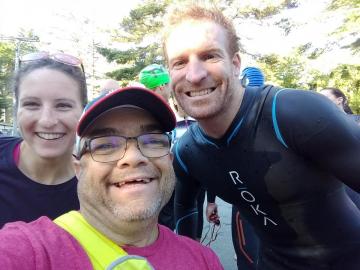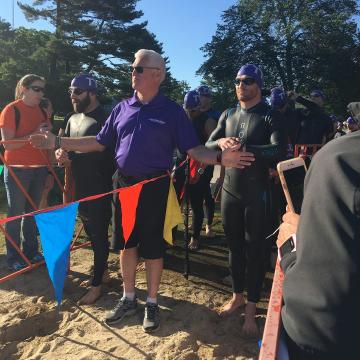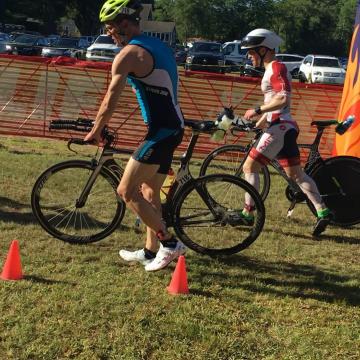Patriot Half-Iron June 16, 2018
Background:
I raced my first half-iron distance race at the Patriot Half in 2016, and you can find that race report here. At that race I missed my goal time of five hours by a mere 17 seconds, which was a pretty frustrating result. In particular, I had a very dissapointing swim, recording a bit over 40 minutes. I tried to get my under my five hour goal later in the summer at Pumpkinman, only to have the run cancelled after sever thunderstorms came through on the bike. That race report is here.
Going into the 2017 summer racing season I was very focused on finally getting that sub-five finish, and signed up for Musselman in Geneva, NY as my goal race for the early season. Unfortunately, the summer of 2017 and I just really didn't seem to get along. I crashed on the bike during the "Oh My Goddard" olympic distance race in June, my first DNF, then injured my foot in late June a couple weeks before Musselman. Thinking it was peroneal tendonitis I tried to race, which was a really poor decision. The stress of the injury and unrealistic expectations of going under five really messed with my head, and I had a complete meltdown of a swim, breastroking a significant portion and finishing in around 42 minutes. While the bike went fine, I realized soon after starting the run that my foot was in bad shape. I should have switched to the aquabike in the weeks leading up to the race, or stopped at mile one on race day, but instead I pushed through the pain for six miles before pulling the plug. It was a really tough day all around. I eventually got an MRI of my foot several weeks leter, revealing I had a fracture in my fourth metatarsal, causing me to spend almost 12 weeks in a walking boot. While I continued to swim during that time, I was out of running for a siginificant portion of 2017.
Training:
Leading into the 2018 season I decided to start working with coach Mike Espejo for a few reasons. First, this was my first year as full time faculty at Olin College and my planning and training time was limited. I am also coaching the Wellesley College sailing team which adds to the time constraints. Having a coach allows me to focus on just executing each workout and trusting the process, which has been a huge benefit. The second reason was to focus on getting to the starting line healthy. I have a history of over use injuries, and having an external set of eyes making sure I wasn't doing dumb things was really helpful. Mike was fantastic at working within the constraints of my schedule and adapting sessions when necessary. He was responsive to feedback, and I think we are working well together. Overall, the training program focused on consistency, with few days completely off, and generally 10-13 quality hours per week. Most of my bike training was done indoors using custom created workouts on Trainerroad, and run training built very greadually out of respect for my foot and hip injuries.
The other huge factor in my training for this season was to join the Wellesley Masters swim team in September. The structure, volume, and intensity of masters completely changed my perspective on swim training. I actually really enjoy practice, and am motivated to improve across all four strokes. An added bonus of masters is leaving the house at 5am to make a 5:45am practice really helps avoid traffice during my commute!

Swim: 34:14, 1:38/100yds, 7/26 AG, 97/580 OA, 6:23 faster than 2016, (my score: 8/10)
The swim has historically been the weakest part of my triathlon racing, but I have worked very hard over the last couple seasons to close that gap. I joined the Wellesley Masters swim team in September of 2017 when I started my faculty position at Olin College, and consistently swam three ~3800 yard practices a week leading up to Patriot. Not only was this a step up in yardage compared to previous seasons, but swimming with a team has pushed me to swim workouts and sendoff times I would never have tried on my own. Swimming masters also forced me to swim all four strokes, which I believe has been very beneficial to my overall swimming. One other thing I focused on in my training was to incorporate more sets with paddles in hopes of building muscular endurance for swimming in a wetsuit. I didn't swim much open water before Patriot, but was able to get in three swims in my wetsuit at Walden in the ten days leading up to race day which definitely helped me get reacquainted with wetsuit swimming.
One dilemma I had with the swim was whether or not to have the top of my trisuit pulled up under my setuit. I have a Castelli short sleeve suit, and the cuffs of the sleeves are very tight- great for aero, but slightly annoying swimming. After practicing a few times at Walden, I decided to swim with my top down under the wetsuit and pull the sleeves on during the run to my bike in T1. I knew I might lose some time in transition, but feeling comfortable in the swim was a high priority, especially after my swim troubles in previous races.
On race day the male 34 and under wave was the 7th to start, meaning there was a pretty long wait between the warmup swim and race start. I had a Hotshot 30 minutes before the start and a Double Espresso Clif Gel with 15 minutes to go. For the start I tried to line up with another athlete hoping to swim ~35 minutes, but we got separated very quickly. The swim went well in general, I felt very smooth and consistent the entire time, with no dark moments as has been the case during other races. Early in the swim I looked at my watch and saw I was swimming a bit too hard, so eased back a bit and focused on hand position, keeping my stroke wide, and finishing my pull at the hip. I was able to find some feet for about a third of the swim and contact with other athletes wasn't too bad. After making the turn back towards shore I glanced at my watch again and noticed the screen had changed, so a button must have been bumped by another athlete. I figured I would no longer have a swim time on my watch, but looking around I saw more caps from the wave ahead than my wave, and that gave me confidence that I was actually swimming ok, and I just neeed to focus on keeping my turnover up and not letting the place slide. Exiting the water I saw 34:xx on my watch, which put me in great spirits for the rest of the day.

T1: 2:28, 30 seconds slower than 2016
Exiting the water from the swim my focus was on getting my wetsuit top down and trisuit on as quickly as possible. I skipped the wetsuit strippers so I could focus on my sleeves, but had issues with the zipper of my trisuit which lost me some time. My heart rate monitor had also slid down around my waist during the swim, so I just took it off and left it in transition. In the past I have biked sockless in tri shoes and have done a flying mount on the bike, but my foot injury has caused me to only wear my road shoes with socks, so overall I knew transition would be a bit slower. Despite the trisuit zipper issues, I was happy trading 30 seconds in transition for a very comfortable PR swim.
Bike: 2:31:09 (22.2 mph), 3/26 AG, 38/580 OA, NP=193W, AP=184W, IF=0.78, 6:55 faster than 2016, (my score: 7/10)
The plan for the bike was to ride 185-195 watts for loop one and closer to 200 for loop two. Best Bike Split predicted ~2:31 for a Normalized Power of 196 W, which is pretty darn close to where things ended up. Being in one of the last waves, loop one was very crowded, and there weren't many opportunities to put the head down and settle in to steady power. Instead I had to make a lot of decisions about when to put in small surges to pass other riders, and I may have burned a couple matches more than I should have. I started taking in nutrition about ten minutes into the ride, sticking with three Clif Bloks about every 20 minutes, and my first bottle of fluids was lemon-lime NUUN. I only had one bottle cage on the bike (behind the seat was a flat kit) and I ran a bit short on fluids before the first aid station, but otherwise that approach worked just fine.
Loop two was a bit more spread out, and I was able to ride a more consistent pace. The goal was a to ride loop two a bit faster than loop one, but I encountered a couple vehicles on the road which slowed me down, and ended up with a very slightly slower split. While I didn't end up increasing the power on lap two, I think I rode consistently strong throughout the ride, and my watts/speed suggest a fast day and that my position and equipment are on the right track. I took a Hotshot with 30 minutes left on the bike to prep for the run, and had a Clif Gel with 15 minutes left in the ride to allow my stomach to settle for the run. Huge thanks to the volunteers and police who did a great job at intersections and kept the course safe! My only complaint on the course were tons of athletes riding too far to the left, making passing very difficult at times.

T2: 2:16, a whole 1 second faster than 2016
Nothing special, except I had trouble getting my race belt buckled. Maybe I should just step into it in the future.
Run: 1:45:41, 8:04/mile, 9/26 AG, 74/580 OA, 8:13 slower than 2016 (my score: 3/10)
I knew my run was a question mark coming into the race, but was hoping I could run a similar or slightly slower pace to my 2016 race. We knew the run was going to be very hot and exposed, and I have been working hard on not over extending in the first couple miles off of the bike. It was great to see Lianne and our good friend John Young leaving transition, and I knew I had a margin on my goal of sub 5 hours to start the run.
The plan was to run the first few miles conservatively and then build towards and hold ~7:30 pace for the majority of the run. This plan seemed doable for the first 5 miles or so, but when I tried to build the pace a bit the legs just didn't respond. I may have overbiked, or perhaps the 10 weeks in a walking boot caught up to me, but the pace was definitely moving in the wrong direction. The Patriot run course is hot, exposed, and deceptively hilly, and I need to prepare better for those factors. There were some ugly moments during the run where giving up on the sub-5 goal seemed likely, but I had the total race time on my watch and knew that I just needed to hold it together and not blow up if I wanted to make my goal. In some respects I wonder if having the watch and knowing I had a cushion on my time goal subconciusly let me off the hook and caused me not to go as deep into the pain cave on the run as I should have. Then again I could claim I was just being conservative and managing my effort on a tough day- hard to say. Either way, I executed poorly and need to make big improvements on the run if I race another half this season.

Overall: 4:55:44.8, 6/26 AG, 44/580 OA, 4:33 faster than 2016 (my score: 6.5/10)
Results can be found here.
Overall, it was a pretty ok day, and it was gratifying to see the hard work on the swim pay off. There are huge areas for improvement still, especially in run execution, swim drafting, and possibly fueling. I'm looking forward to focusing on guiding for paratriathlon most of the summer, and may race again sometime in the fall, to be determined.
Big thanks to Lianne for putting up with my training, Coach Mike Espejo for the excellent preparation and communication, Coach Emily and my Wellesley Masters teammates for pushing me in practice, and my Olin College students and colleagues for their support and flexibility. Big thanks also to Zuzka, Justin, and Uncle Paul for motivation and support, especially when I was in the Bay Area a couple weeks before the race.
Positives:
- Executed a good swim
- ok bike power
Needs work:
- Run execution was poor
- Too much power variability on the bike
- Most everything

Nutrition:
- Breakfast: Oatmeal with peanut butter and a banana, coffee, one bottle of NUUN
- Pre-race: 1 HotShot, 1 Double Espresso Clif Gel
- Bike: 12 x Margarita Shot Bloks, 6 x Salted Watermelon Shot Bloks (3 every 20 min), 1 Lemon-Lime Clif Gel, 1 HotShot, One bottle NUUN, 3 bottles water
- Run: 2 x Clif Gel, started with handheld bottle of NUUN, water/gatorade to thirst
Equipment:
- Wetsuit: Roka Maverick Comp full
- Goggles: Aquasphere Kaiman
- Bike: 2012 Felt B12
- Saddle: Fabric Tri
- Powermeter: Power2Max Type S FSA Gossamer with 165mm cranks and 52/36 rings
- Tires/Tubes: Specialized S-Works Turbo 24mm, Vittoria latex tubes
- Disc cover: Wheelbuilder Aerojacket
- Hydration: One cage zip-tied between the arms
- Nutrition storage: Dark Speed Works Speedpack 483
- Flat kit: Flat kit in bottle behind seat. Contained 1 tube, 2 xC02 , 1 tire lever, allen keys, mini pump
- Helmet: Giro Aerohead
- Kit: Castelli San Remo short sleeve MIT kit, CEP calf sleeves
- Bike Shoes: Specialized expert road (best for foot issues)
- Run shoes: Saucony Kinvara
- Handheld bottle: Nathan QuickShot plus
- Inspiration: Teach Access sticker on disc cover